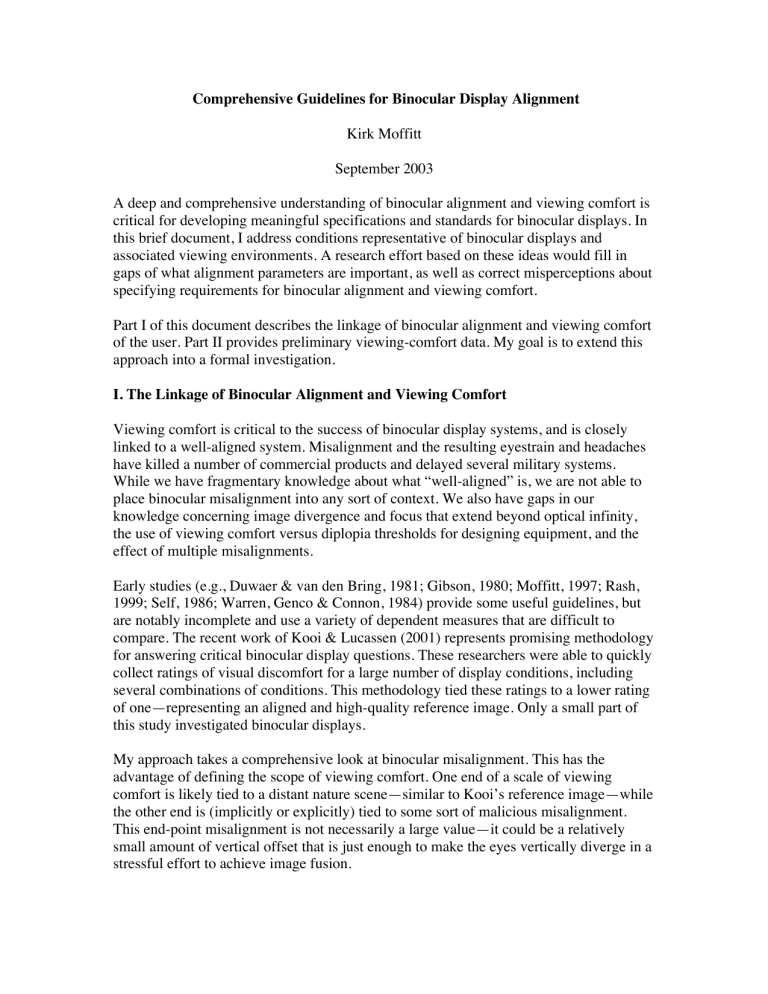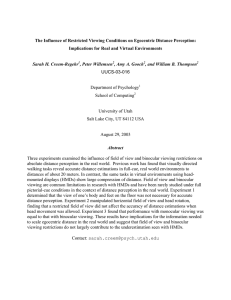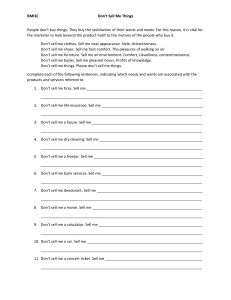
Comprehensive Guidelines for Binocular Display Alignment Kirk Moffitt September 2003 A deep and comprehensive understanding of binocular alignment and viewing comfort is critical for developing meaningful specifications and standards for binocular displays. In this brief document, I address conditions representative of binocular displays and associated viewing environments. A research effort based on these ideas would fill in gaps of what alignment parameters are important, as well as correct misperceptions about specifying requirements for binocular alignment and viewing comfort. Part I of this document describes the linkage of binocular alignment and viewing comfort of the user. Part II provides preliminary viewing-comfort data. My goal is to extend this approach into a formal investigation. I. The Linkage of Binocular Alignment and Viewing Comfort Viewing comfort is critical to the success of binocular display systems, and is closely linked to a well-aligned system. Misalignment and the resulting eyestrain and headaches have killed a number of commercial products and delayed several military systems. While we have fragmentary knowledge about what “well-aligned” is, we are not able to place binocular misalignment into any sort of context. We also have gaps in our knowledge concerning image divergence and focus that extend beyond optical infinity, the use of viewing comfort versus diplopia thresholds for designing equipment, and the effect of multiple misalignments. Early studies (e.g., Duwaer & van den Bring, 1981; Gibson, 1980; Moffitt, 1997; Rash, 1999; Self, 1986; Warren, Genco & Connon, 1984) provide some useful guidelines, but are notably incomplete and use a variety of dependent measures that are difficult to compare. The recent work of Kooi & Lucassen (2001) represents promising methodology for answering critical binocular display questions. These researchers were able to quickly collect ratings of visual discomfort for a large number of display conditions, including several combinations of conditions. This methodology tied these ratings to a lower rating of one—representing an aligned and high-quality reference image. Only a small part of this study investigated binocular displays. My approach takes a comprehensive look at binocular misalignment. This has the advantage of defining the scope of viewing comfort. One end of a scale of viewing comfort is likely tied to a distant nature scene—similar to Kooi’s reference image—while the other end is (implicitly or explicitly) tied to some sort of malicious misalignment. This end-point misalignment is not necessarily a large value—it could be a relatively small amount of vertical offset that is just enough to make the eyes vertically diverge in a stressful effort to achieve image fusion. I see a need for comprehensive guidelines for symbology imaged against a real-world scene. The most urgent need is for standards for military aviation—a distant scene as viewed through a canopy. A secondary application is the imaging of computer graphics against a nearby object or field—for use in surgical guidance and medical diagnosis. The outcome of this research would answer the following types of questions: 1. What is the scope or scale of visual comfort for binocular imagery? Are there natural endpoints? How do multiple misalignments (including disparate left/right focus) combine to affect visual comfort? Would multiple dimensions add clarity to this problem? 2. How do binocular misalignments interact with the eyebox and IPD adjustability to affect viewing comfort? 3. Should binocular alignment beyond parallel eyes be specified? The alternative is a range starting at zero and ending at some amount of ocular convergence. 4. Should focus be specified as a tolerance (e.g., 0D plus and minus 1/4 D), or as a range starting at optical infinity and ending at some amount of near focus? 5. Is the perceived intermediate distance of symbology a fundamental limitation of viewing comfort? If so, then the best we can do is achieve some level of acceptable comfort. 6. Given that the misalignment of vergence and focus is inherent in stereo displays, is there also a fundamental limitation of viewing comfort? What is the viewingcomfort advantage versus perceptual disadvantage of limiting binocular disparity (i.e., microstereopsis)? Answers to these questions will allow the designer of binocular imaging systems to prioritize alignment requirements, specify vergence and focus with confidence, and start with a realistic expectation of achievable viewing comfort. For the military, this knowledge can translate into the savings of millions of dollars. For industry, this can pave the way for product success. In addition, this knowledge can lessen the risk of health hazards and safety litigation. II. Preliminary Data on Binocular Alignment and Viewing Comfort Median data from three observers are presented from a preliminary investigation of visual comfort and binocular alignment. Observers briefly viewed binocular imagery and provided a rating of visual comfort on the following scale: 1 2 3 4 5 Not uncomfortable A little uncomfortable Somewhat uncomfortable Very uncomfortable Extremely uncomfortable 2 The baseline image was green symbology viewed against a colorful scenic background. This image in perfect alignment was explicitly linked to a rating of 1 – Not uncomfortable to view, and was briefly viewed between trials. The three observers were simply instructed to rate the comfort of viewing the image. There were no explicit instructions to “fixate” the background or symbology, and there was no task to perform. After the initial aligned image, observers viewed a random sequence of misaligned images at the distance of optical infinity. This misalignment was either Local (the symbology but not the background was shifted) or Global (both the symbology and background were shifted). Misalignments included Horizontal (convergence or plus, divergence or negative), Vertical, Magnification difference, and Rotation difference (rotation was outwards). Several combinations of misalignments were tested. In addition, the aligned image was tested at several positive (closer than optical infinity) and negative (further than optical infinity) focus values with an image vergence corresponding to optical infinity or parallel lines-of-sight. Notations for each set of conditions are: H0 H+1 H+3 H+6 H+9 H+12 H0 H-3 H-6 H-9 H-12 V0 V3 V6 V9 V12 M0 M1 M2 M3 R0 R1 R2 R3 H0 H+60 H+120 global H0 H-60 H-120 global V0 V15 V30 V45 V60 global M0 M1 M2 M3 global R0 R1 R2 R3 global -1/2 –1/4 0 +1/4 +1/2 D Relative horizontal misalignment of 0 to +12 min Relative horizontal misalignment of 0 to -12 min Relative vertical misalignment of 0 to 12 min Relative magnification of 0 to 3% Relative rotation of 0 to 3 deg Global horizontal misalignment of 0 to +120 min Global horizontal misalignment of 0 to –120 min Global vertical misalignment of 0 to 60 min Global magnification of 0 to 3% Global rotation of 0 to 3 deg Global focus of –1/2 to +1/2 diopter 3 These preliminary data are presented as grouped median ratings with commentary: Rating of 1: Not uncomfortable to view H0 V0 M0 R0 0D Local Perfect alignment baseline H+1 V0 M0 R0 0D Local Gibson’s (1980) preferred value H+6 V0 M0 R0 0D Local 35 meters H-3 V0 M0 R0 0D Local H0 V3 M0 R0 0D Local H-60 V0 M0 R0 0D Global 20x H-3 local H0 V15 M0 R0 0D Global 5x V3 local H0 V0 M1 R0 0D Global H0 V0 M0 R0 +1/4D Global Tolerance for small amount of close focus Rating of 2: A little uncomfortable to view H+3 V0 M0 R0 0D Local H+9 V0 M0 R0 0D Local H+12 V0 M0 R0 0D Local Tolerance for close symbology, 17 meters H-6 V0 M0 R0 0D Local H0 V0 M1 R0 0D Local H0 V0 M2 R0 0D Local H+60 V0 M0 R0 0D Global Greater tolerance for convergent global H0 V30 M0 R0 0D Global H0 V0 M2 R0 0D Global H0 V0 M0 R0 +1/2D Global Rating of 3: Somewhat uncomfortable to view H0 V6 M0 R0 0D Local H+3 V6 M0 R0 0D Local H0 V0 M3 R0 0D Local H0 V0 M0 R1 0D Local H+120 V0 M0 R0 0D Global H-120 V0 M0 R0 0D Global H0 V0 M3 R0 0D Global H0 V0 M0 R2 0D Global H0 V0 M0 R3 0D Global Greater tolerance for global R H0 V0 M0 R0 -1/4D Global Rating of 4: Very uncomfortable to view H-9 V0 M0 R0 0D Local H0 V9 M0 R0 0D Local H0 V12 M0 R0 0D Local H-6 V6 M0 R0 0D Local Combination degrades comfort H0 V45 M0 R0 0D Global Up to 5x V local H0 V0 M0 R1 0D Global Ratings for global R not consistent H-60 V60 M0 R0 0D Global H0 V0 M0 R0 -1/2D Local Note ordering of focus, small + to large - 4 Rating of 5: Extremely uncomfortable to view H-12 V0 M0 R0 0D Local H0 V0 M0 R2 0D Local H0 V0 M0 R3 0D Local H0 V60 M0 R0 0D Global H0 V60 M1 R0 0D Global In agreement with previous studies, these preliminary data suggest that we are more sensitive to vertical than horizontal misalignment. We are also much more sensitive to local or relative misalignment than to global misalignment. Combinations of misalignments produced some of the highest ratings of viewing discomfort. We also respond differently to the same amount of convergence and divergence, as well as focus nearer and further than the reference. For a preliminary sample of three observers with minimal practice and only cursory instructions, the data are remarkably consistent. Some of the few inconsistencies, such as global rotation, may actually indicate that smaller values create more discomfort. This could be due to torquing of the eyes in response to the smaller value and the resulting tension, while larger values are simply seen as a confused image. A reasonable sample size would allow for a more confident explanation. Despite a variety of conditions that were presented in a random order, the three observers had no trouble rating each image for level of discomfort. This suggests that non-binocular conditions that simulate a monocular display or that replicate perceptual effects could be included. These types of conditions could further help place binocular alignment into a cohesive viewing-comfort context. References Duwaer, A. L., & van den Brink, G. (1981). Diplopia thresholds and the initiation of vergence eye movements. Vision Research, 21, 1727-1737. Gibson, C.P. (1980). Binocular disparity and head-up displays. Human Factors, 22, 435444. Kooi, F. L., & Lucassen, M. (2001). Visual comfort of binocular and 3-D displays. Proceedings of the SPIE, Vol. 4299, 586-592. Moffitt, K. (1997). Designing HMDs for viewing comfort. In J. E. Melzer & K. Moffitt (eds.), Head mounted displays. New York: McGraw-Hill. Rash, C. E. (1999). Helmet-mounted displays: Design issues for rotary-wing aircraft. Fr. Rucker AL: U.S. Army Aeromedical Research Laboratory. 5 Self, H. C. (1986). Optical tolerances for alignment and image differences for binocular helmet-mounted displays. Air Force Technical Report AAMRL-TR-84-019. WrightPatterson AFB OH: Air Force Aeromedical Research Laboratory. Warren, R., Genco, L.V., & Connon, T. R. (1984). Horizontal diplopia thresholds for head-up displays. Technical Report AFAMRL-TR-84-018. Wright-Patterson AFB OH: Air Force Aeromedical Research Laboratory. About the author Kirk Moffitt is a human factors consultant who specializes in virtual display systems. For more information, visit http://www.kirkmoffitt.com or contact at kirkmoffitt@verizon.net. 6

